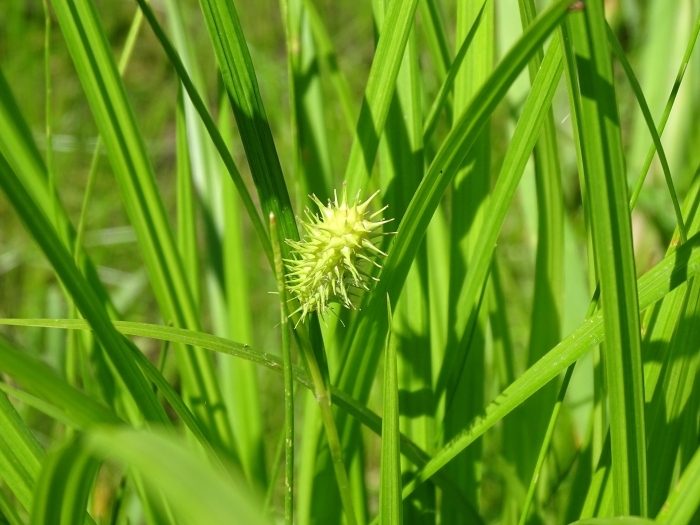Bottlebrush Sedge
(Carex hystericina)
Bottlebrush Sedge (Carex hystericina)
/
/

Reuven Martin
Public Domain
Image By:
Reuven Martin
Recorded By:
Copyright:
Public Domain
Copyright Notice:
Photo by: Reuven Martin | License Type: Public Domain | License URL: http://creativecommons.org/publicdomain/zero/1.0/ | Rights Holder: Reuven Martin | Publisher: iNaturalist | Date Created: 2020-07-25T11:02:05-07:00 |














































Estimated Native Range
Summary
Carex hystericina, commonly known as bottlebrush sedge or porcupine sedge, is a perennial herbaceous plant native to wet meadows, marshes, and the edges of water bodies in Southern Canada and the colder parts of the United States. It forms dense or loose clumps of triangular stems that can reach up to a meter in height, emerging from short rhizomes. The inflorescence, resembling a bottlebrush, is several centimeters long and is accompanied by a bract that is longer than the spikes, with fruits encased in perigynia featuring pointed, toothed tips. The flowering season extends through late spring and early summer, with the inflorescences being somewhat showy due to their unique structure.
Bottlebrush sedge is highly recommended for sedge meadow restorations and is valued for its ability to thrive in wet conditions, making it suitable for rain gardens, water edges, and naturalized areas. It is also used to stabilize soil and prevent erosion. This sedge is adaptable to a range of light conditions from full sun to full shade and prefers consistently moist to wet soils with medium drainage. While it can be very abundant, it is not typically aggressive or weedy in a garden setting. However, it may require management to maintain desired aesthetics or prevent it from outcompeting other plants in a mixed planting.CC BY-SA 4.0
Bottlebrush sedge is highly recommended for sedge meadow restorations and is valued for its ability to thrive in wet conditions, making it suitable for rain gardens, water edges, and naturalized areas. It is also used to stabilize soil and prevent erosion. This sedge is adaptable to a range of light conditions from full sun to full shade and prefers consistently moist to wet soils with medium drainage. While it can be very abundant, it is not typically aggressive or weedy in a garden setting. However, it may require management to maintain desired aesthetics or prevent it from outcompeting other plants in a mixed planting.CC BY-SA 4.0
Plant Description
- Plant Type: Grass
- Height: 1-3 feet
- Width: 1-3 feet
- Growth Rate: Moderate
- Flower Color: N/A
- Flowering Season: Spring, Summer
- Leaf Retention: Evergreen
Growth Requirements
- Sun: Full Sun, Part Shade, Full Shade
- Water: High
- Drainage: Medium
Common Uses
Bird Garden, Deer Resistant, Low Maintenance, Street Planting, Water Garden
Natural Habitat
Native to wet meadows, marshes, and the edges of water bodies
Other Names
Common Names: Porcupine Sedge , Carex Porc-Épic
Scientific Names: Carex hystericina , Carex hystericina var. dudleyi , Carex hystericina f. hystericina , Carex cooleyi , Carex hystericina f. dudleyi , Carex hystericina var. cooleyi , Carex erinacea , Carex georgiana , Carex hystericina var. angustior
GBIF Accepted Name: Carex hystericina Muhl. ex Willd.